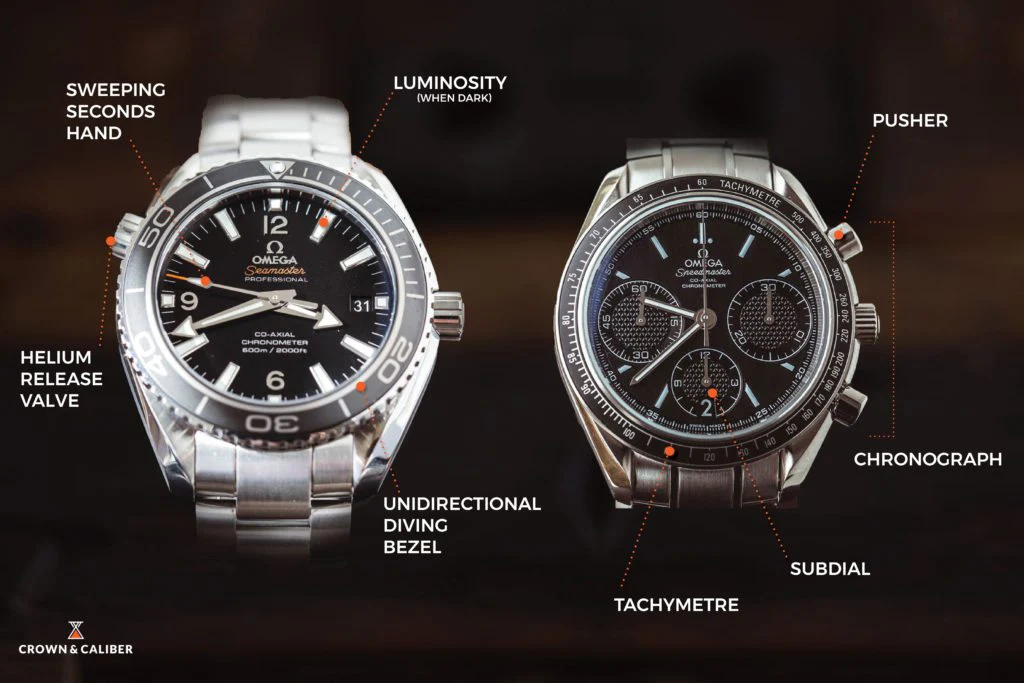Blog
“The Hidden Meaning Behind Watch Hands and Indices”
A watch is more than just a timekeeping device—it’s a reflection of history, culture, and personal style. Among the various elements that make up a watch’s design, hands and indices stand out as key features that are both functional and symbolic. While they help us read the time, they also convey messages about the watch’s purpose, heritage, and design philosophy. For watch enthusiasts, understanding the hidden meanings behind these elements can deepen the appreciation for a timepiece. Let’s explore the fascinating world of watch hands and indices and uncover their secrets.
1. Watch Hands: Style Meets Functionality
The hands of a watch are arguably its most functional component, but they are also rich in history and design significance. The shape, length, and style of watch hands often hint at the watch’s origin, purpose, and intended audience.
Common Types of Watch Hands and Their Meanings:
Dauphine Hands
- Design: Triangular, tapered, and elegant.
- Meaning: Dauphine hands are often found on dress watches, symbolizing refinement and timeless elegance. Their sharp, pointed design reflects precision and sophistication.
- Example: Often seen in luxury watches like those from Patek Philippe and Vacheron Constantin.
Sword Hands
- Design: Straight, bold, and sword-like.
- Meaning: Sword hands convey strength and clarity, making them popular in tool watches like military or pilot watches. Their bold design ensures high legibility.
- Example: Found in iconic models like the Omega Seamaster.
Leaf (Feuille) Hands

- Design: Curved and leaf-shaped.
- Meaning: Leaf hands exude grace and are commonly seen on classic or vintage watches. They emphasize artistry and craftsmanship.
- Example: Featured on many Breguet models.
Cathedral Hands
- Design: Intricate, with segments resembling church windows.
- Meaning: Associated with heritage and tradition, cathedral hands often appear on pilot and vintage watches, symbolizing a connection to history.
- Example: Prominent in early military watches and models like the Longines Heritage series.
Skeleton Hands
- Design: Hollowed-out or openwork.
- Meaning: Skeleton hands emphasize the watch’s mechanical nature and are often paired with skeletonized dials, showcasing the movement beneath. They represent innovation and technical mastery.
- Example: Frequently seen in watches from brands like Hublot and Audemars Piguet.
Mercedes Hands
- Design: A distinctive circular symbol resembling the Mercedes-Benz logo at the tip.
- Meaning: Synonymous with ruggedness and adventure, these hands are iconic in diving watches like the Rolex Submariner. They ensure high visibility underwater.
- Example: Exclusively associated with Rolex sports watches.
2. Watch Indices: Markers with Meaning
Indices, or markers, on a watch face indicate the hours and contribute to the overall design. The style of indices can provide clues about the watch’s function, era, and target audience.
Types of Watch Indices and Their Significance:
Arabic Numerals
- Design: Full or partial set of numbers (1–12).
- Meaning: Watches with Arabic numerals prioritize legibility and are often seen in field watches, aviation watches, and casual styles. They emphasize functionality and are ideal for practical use.
- Example: Pilot watches from IWC or the Zenith Pilot series.
Roman Numerals
- Design: Classic Roman numeral markers (I, II, III…).
- Meaning: Roman numerals evoke heritage, luxury, and formality, making them a staple in dress watches. They symbolize tradition and timelessness.
- Example: Cartier Tank and Breguet Classique models.
Baton Indices
- Design: Thin, rectangular markers.
- Meaning: Baton indices are minimalistic and versatile, often used in modern and dress watches. They reflect a clean, understated aesthetic.
- Example: Popular in watches like the Omega Constellation and Rolex Datejust.
Dot Indices
- Design: Circular markers, often luminous.
- Meaning: Dot indices are commonly seen in diving watches, where legibility in low-light conditions is critical. They signify practicality and utility.
- Example: The Seiko Prospex and Rolex Submariner.
Mixed Indices
- Design: A combination of numerals, dots, or shapes.
- Meaning: Mixed indices highlight the watchmaker’s creativity and are often used in sport or fashion-forward watches. They suggest versatility and uniqueness.
- Example: TAG Heuer Carrera models.
No Indices (Minimalist Design)
- Design: No markers, only a blank dial or very subtle indicators.
- Meaning: A lack of indices emphasizes minimalism and elegance, often seen in watches designed for aesthetic appeal rather than function. They symbolize simplicity and modernity.
- Example: Watches from brands like Nomos or Movado.
3. Cultural and Symbolic Impacts
The design of watch hands and indices often reflects the culture and era in which a watch was created. For example:
- Art Deco Style (1920s–1930s): Watches from this era featured geometric, stylized hands and markers, embodying the glamour and modernity of the time.
- Military Influence (1940s): Wartime watches prioritized legibility and durability, with bold indices and luminous hands designed for functionality.
- Space Age (1960s): The rise of space exploration inspired futuristic designs with bold, unconventional hands and markers, reflecting humanity’s fascination with innovation.
4. Functionality Meets Aesthetics
For many watches, the design of hands and indices serves both functional and decorative purposes. Luminescent materials, for instance, are often applied to hands and markers to improve visibility in low-light conditions. These lumed components are especially important in diving, field, and aviation watches, ensuring that the watch remains practical in extreme conditions.

- Lume Styles:
- C3 Super-LumiNova: Bright green glow, used for maximum legibility.
- Old Radium: A vintage-style lume that mimics aged tritium, offering a nostalgic appeal.
5. The Collector’s Perspective
For collectors, the design of hands and indices is more than just an aesthetic choice—it’s a key indicator of a watch’s authenticity and historical value. Small variations in the shape or placement of these elements can signify different production years or limited editions, making them critical to identifying rare or collectible models.
- Examples:
- The Rolex “Maxi Dial” Submariner is valued for its larger indices, which differ from standard models.
- Vintage pieces with patina on indices and hands are often highly prized for their aged, unique character.
Conclusion
The hands and indices of a watch are much more than time-telling tools—they’re rich with history, symbolism, and artistry. From the precision of Dauphine hands to the boldness of Arabic numerals, every element on a watch dial tells a story about its purpose, heritage, and design philosophy. For enthusiasts, these subtle details are a testament to the craftsmanship and thoughtfulness that define the world of horology. The next time you glance at your watch, take a moment to appreciate the hands and markers—they’re the unsung heroes that bring your timepiece to life.

